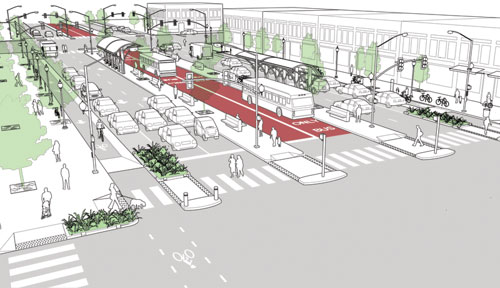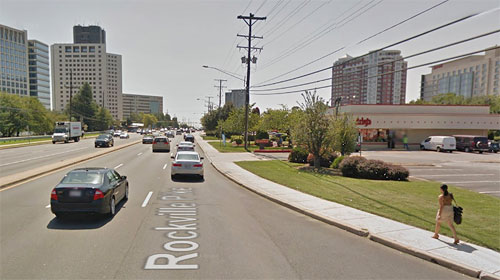Montgomery County’s BRT challenge: Getting it right
Montgomery County is starting to plan the specific details for the 81-mile Bus Rapid Transit project county leaders approved last year. Its success will depend heavily upon whether the current wide, fast roads stay that way and just get bus lanes added on, or whether they become pedestrian- and bicycle-
friendly boulevards that welcome transit riders and respond to community needs.

A transit corridor street design by the National Association of Transportation Officials with 10’ lanes, pedestrian refuges, and cycletracks.
Last summer, the Maryland State Highway Administration (SHA) released initial designs for BRT on Georgia Avenue North. The plan called for too many lanes that, at 12 to 14 feet, were far too wide, and unnecessarily large buffer zones that altogether would have required the use of eminent domain.
According to Jeff Speck, a smart growth expert, the wide lanes would be “disastrous for safety” because research shows they encourage speeding.
Yet most of the corridors Montgomery plans to use for BRT are fast, six-lane roads. Sidewalks squeeze against the side. Intersections bulge out with multiple turn lanes and corners with high-speed, sweeping right turns.
In other words, Montgomery County is planning to install BRT on roads that cyclists and pedestrians alike avoid for safety reasons, a measure that will limit access to key intersections and strengthen barriers between communities and destinations.

The Maryland State Highway Administration’s proposed cross section for Alternative 5 for BRT on Georgia Avenue features 12’ and 14’ lanes.
It’s important to get the design details right from the start
Putting BRT on these roads without making other fundamental changes to the road’s design would not only discourage walking and bicycling, but also keep transit ridership down. By planning an environment that’s welcoming of pedestrians and bicycles, Montgomery County can transform key arterials into attractive, safe, multi-modal boulevards that better serve all users.

High speed right turns, and sidewalks up against high speed traffic make Rockville Pike an unpleasant place to walk. Image from Google Maps.
Planning for pedestrians and cycles isn’t just a nice thing to do; it’s also good business because it increases access to commerce. Chuck Marohn, an engineer who writes Strong Towns, would likely call most of Montgomery’s BRT corridors “stroads,” or street/road hybrids that “[move] cars at speeds too slow to get around efficiently but too fast to support productive private sector investment.” Many strip retail centers and malls along our high speed stroads are struggling while businesses are thriving in walkable downtowns and new, mixed-use centers.
Other communities around the country have wisely invested in making BRT corridors more accessible for pedestrians and cyclists. Oakland, for example, is planning what has been called “California’s longest complete street” for International Boulevard, its BRT corridor. Oakland’s 17-mile BRT system, scheduled to open in 2016, will have wider sidewalks, bulbouts, streetlights, and bicycle lanes (some of them protected) along the entire length.

UC Berkeley student recommendations for improved pedestrian and bicycle accommodations on the International Boulevard BRT corridor.
How community members can get involved
Representative community input will also be critical to designing a successful system, as residents are the ones who know where safety hazards and trouble spots exist.
The SHA and Montgomery County Department of Transportation (MCDOT) have formalized a way for community members to give feedback on the first four of Montgomery’s ten planned BRT routes (Viers Mill Road from Rockville to Wheaton, Georgia Avenue North from Olney to Wheaton, MD 355 from Clarksburg to Bethesda, and US 29 from Burtonsville to Silver Spring). Each site will have a Bus Rapid Transit Corridor Advisory Committee that, starting in December, will meet every other month to address where stations should go, where bike and pedestrian routes are needed, and how the street should be designed.
The committees are an important chance for residents, businesses, and other stakeholders to achieve consensus and help get the details right. If a diverse and representative range of community members answers the call for applications, Montgomery County can not only dramatically improv its transit service, but also turn some auto-oriented corridors into walkable, bikeable places.
